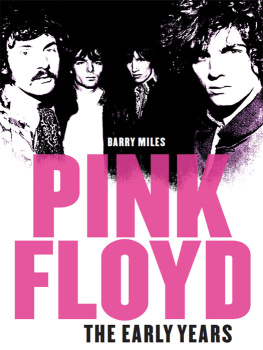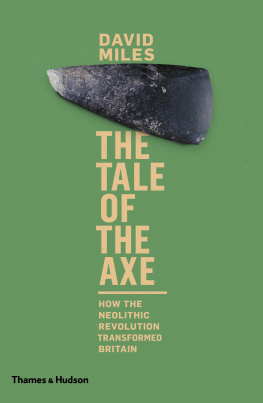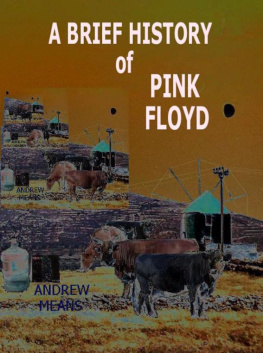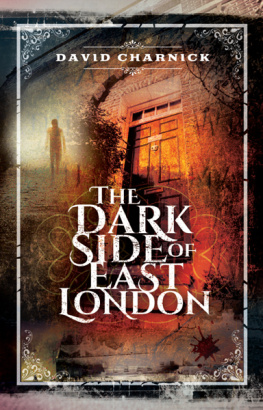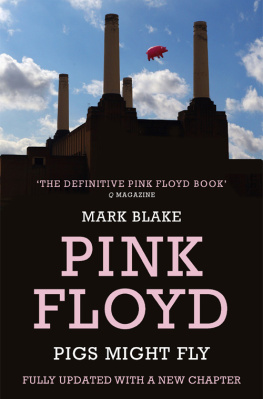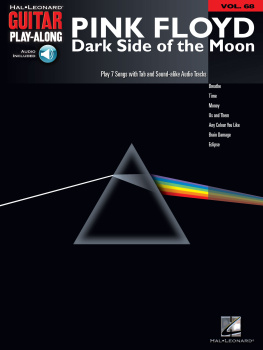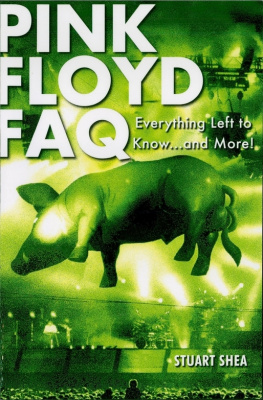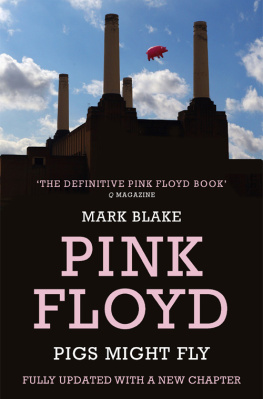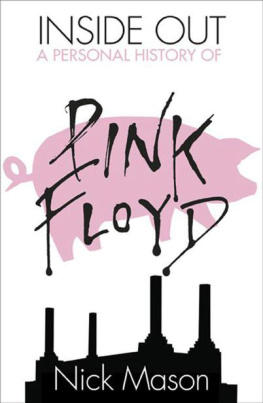Miles - Pink Floyd: the early years
Here you can read online Miles - Pink Floyd: the early years full text of the book (entire story) in english for free. Download pdf and epub, get meaning, cover and reviews about this ebook. City: England, year: 2006;2011, publisher: Music Sales Limited;Omnibus, genre: Non-fiction. Description of the work, (preface) as well as reviews are available. Best literature library LitArk.com created for fans of good reading and offers a wide selection of genres:
Romance novel
Science fiction
Adventure
Detective
Science
History
Home and family
Prose
Art
Politics
Computer
Non-fiction
Religion
Business
Children
Humor
Choose a favorite category and find really read worthwhile books. Enjoy immersion in the world of imagination, feel the emotions of the characters or learn something new for yourself, make an fascinating discovery.
- Book:Pink Floyd: the early years
- Author:
- Publisher:Music Sales Limited;Omnibus
- Genre:
- Year:2006;2011
- City:England
- Rating:3 / 5
- Favourites:Add to favourites
- Your mark:
- 60
- 1
- 2
- 3
- 4
- 5
Pink Floyd: the early years: summary, description and annotation
We offer to read an annotation, description, summary or preface (depends on what the author of the book "Pink Floyd: the early years" wrote himself). If you haven't found the necessary information about the book — write in the comments, we will try to find it.
Miles: author's other books
Who wrote Pink Floyd: the early years? Find out the surname, the name of the author of the book and a list of all author's works by series.
Pink Floyd: the early years — read online for free the complete book (whole text) full work
Below is the text of the book, divided by pages. System saving the place of the last page read, allows you to conveniently read the book "Pink Floyd: the early years" online for free, without having to search again every time where you left off. Put a bookmark, and you can go to the page where you finished reading at any time.
Font size:
Interval:
Bookmark:



Copyright 2006 Omnibus Press
This edition 2011 Omnibus Press
(A Division of Music Sales Limited, 14-15 Berners Street, London W1T 3LJ)
EISBN: 978-0-85712-740-2
The Author hereby asserts his / her right to be identified as the author of this work in accordance with Sections 77 to 78 of the Copyright, Designs and Patents Act 1988.
All rights reserved. No part of this book may be reproduced in any form or by any electronic or mechanical means, including information storage and retrieval systems, without permission in writing from the publisher, except by a reviewer who may quote brief passages.
Every effort has been made to trace the copyright holders of the photographs in this book, but one or two were unreachable. We would be grateful if the photographers concerned would contact us.
A catalogue record of this book is available from the British Library.
Book designed by: Matt Brown, Designbranch
Cover designed by: Michael Brown Design
For all your musical needs including instruments, sheet music and accessories, visit www.musicroom.com
For on-demand sheet music straight to your home printer, visit www.sheetmusicdirect.com


Despite pressure from property developers, Grantchester Meadows remains a quintessentially English patch of countryside, with muddy paths showing the passage of ducks and foxes, dogs and people, lone fishermen on the banks of the winding River Cam, distant bells from the massed church spires beyond the trees, and everywhere the sound of birdsong. The City of Cambridge is relatively small, around 100,000 people, and is one of the most beautiful cities in Britain, if not the world. It has a very powerful physical presence and visitors cannot avoid feeling a tremendous sense of continuity with the past.
All art forms contain an element of the environment that created them, including rock and roll: Elvis Presley was a southern boy, Fats Domino and Dr John have the deep rolling sound of New Orleans, The Beatles were clearly from Liverpool just as the Rolling Stones were the sound of the London suburbs and Pink Floyd were from Cambridge. Nick Mason and Rick Wright, of course, came from London but the three successive leaders and principal songwriters of the band: Syd Barrett, Roger Waters and David Gilmour were all Cantabrigians.
Elements of their childhood in that city impose themselves on Pink Floyd music in all three of its linked incarnations. No matter how indifferent you may be to ancient buildings it is impossible to spend time in Cambridge without the environment of solid stone walls, the classical volumes and proportions of the buildings, the medieval arrangement of streets and alleys, and the rich patina of age slowing your step, making you aware of the past and reducing the urgency of the present. In the town centre it is still common to see masters and students in gowns and even the occasional mortarboard, the Cam is still thronged with students in punts, and bicycles far outnumber cars in the narrow winding streets of the centre. The country is never far away and the Backs provide an arboreal setting for endless picture postcard views. Ancient bells still ring out from medieval towers and the atmosphere is liturgical: one of learning, of respect for learning; of being part of an historical process.
It is this physical environment, rather than the aural environment (car radios, TV ads) which most American groups had, that is echoed in the architectural structures suggested by Pink Floyds music. Even Syd Barrett showed preference for long improvisational passages defined more by surfaces and textures than by virtuoso guitar pyrotechnics. Roger Waters was the most obviously architectural in the construction of his music but Rick Wright and Nick Mason shared his approach all three were architectural students, of course down to planning songs with diagrams and graphs rather than words scribbled in pencil on the back of an envelope. Even with master rock guitarist Gilmour at the helm, the music suggests the enormous volumes of architecture and is more likely to proceed at the stately pace of a hymn than a Chuck Berry duckwalk.

Pink Floyd, 1967. LR (back): Nick Mason, Rick Wright, (front) Roger Waters, Syd Barrett

Roger (back row, far left) as part of The County High School rugby team, 1960.
As with many groups, the line-up of Pink Floyd was the result of the successive shuffling of players in a series of bands who joined, left and exchanged members in a formal dance that left a lucky few holding a full dance card. On the floor were a circle of friends and acquaintances who knew each other at school in Cambridge and, in many cases, whose parents also knew each other. Various Cambridge, then London-based, groups maneuvered until the band took its final shape. Some of these people played a brief role then moved on, others took on new roles, such as art direction or spouse, while one, David Gilmour, tried a different route before being asked to dance.
George Roger Waters was born on September 9, 1943, the youngest of three boys, in the village of Great Bookham, Surrey, near Dorking, about 20 miles south of London. His father Eric Fletcher Waters, a religious education and physical education teacher, was in Italy serving in the armed forces as a Second Lieutenant with the City of London Regiment of the 8th Battalion Royal Fusiliers under General Leese. His unit was among those that managed a successful landing on January 22 on the beaches at Anzio, 60 miles north of Cassino. This landing behind enemy lines was designed to draw German forces away from the Cassino front so that British and American troops could break through and head north to Rome. The beachhead was consolidated but unfortunately did not break out to engage enemy forces. Parts of the German 14th army were rushed to Anzio as anticipated but they were able to contain the beachhead and pinned down British and American forces in a stalemate. Then, on February 18, 1944, as the allies bombed Monte Cassino prior to the second battle for the ancient monastery, Eric Waters was shot and killed. Roger was five months old.
A big bonfire, and being held up to the window, and people with flags and dancing, and flickering light.
Roger Waters
As if life was not hard enough for the Waters family, on June 13, 1944, the Germans began launching doodlebugs V1 flying bombs against London, many of which overflew Surrey. Several thousand were shot down by artillery or by fighter planes before they reached London, making their flight paths a treacherous place to live. Mary Waters packed her belongings and took her sons, John, the eldest, Duncan and Roger, to Cambridge to start a new life. Roger was two years old. His earliest memory is of VJ night, August 15, 1945: A big bonfire, and being held up to the window, and people with flags and dancing, and flickering light. It was only when his schoolmates began to be picked up from nursery school by their fathers in 1946 when the troops were demobbed that he began asking where
Font size:
Interval:
Bookmark:
Similar books «Pink Floyd: the early years»
Look at similar books to Pink Floyd: the early years. We have selected literature similar in name and meaning in the hope of providing readers with more options to find new, interesting, not yet read works.
Discussion, reviews of the book Pink Floyd: the early years and just readers' own opinions. Leave your comments, write what you think about the work, its meaning or the main characters. Specify what exactly you liked and what you didn't like, and why you think so.

